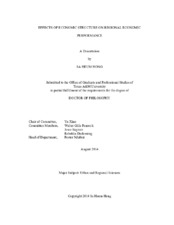| dc.description.abstract | Since the most recent recession, many local governments, which excessively paid attention to economic growth, have undergone tremendous difficulties caused by severe fluctuations. It shows that economic stability also has to be considered as another critical factor that constitutes regional economic performance. Thus, in this dissertation, I evaluate regional economic performance in terms of both growth and stability.
In most previous studies, economic structure was found to be a factor that can affect both growth and stability at the same time. However, in terms of measuring economic structure, diversity and specialization have been commonly treated as the exact opposite, increasing in one means decreasing in the other. Some researchers recognized the existence of multiple specializations in an economy but this concept has never been operationalized and empirically tested. Therefore, I extend the body of previous research by formulating an indicator to empirically measure multiple
specializations in regional economies and examine the effect of multiple specializations on both growth and stability in one framework.
Moreover, the economic structural effects can be estimated differently depending on the macro-economic situations. However, previous studies rarely considered the effects of macro-economic situations when investigating the effect of economic structure. Thus, to overcome this limitation, I apply panel analysis for the same statistical models in the above using the panel data which were constructed with four different time periods based on different macro-economic situations.
The empirical analysis in this study finds that multiple specializations might positively affect economic growth while diversity can hinder growth. Otherwise, this study finds that increasing the levels of both diversity and multiple specializations can help regions to promote economic stability. It suggests that a region with a multiply specialized economic structure is more likely to experience both growth and stability at the same time.
Additionally, the results of panel analyses inform that the effects of economic structure on growth vary across different macroeconomic situations while these structural effects on stability are consistently estimated, regardless of macroeconomic situations. This suggests that the economic development strategy using economic structure may indicate the different effectiveness by their objectives (i.e., growth or stability) or the macro-economic situations (i.e., boom or bust). | en |


